Green
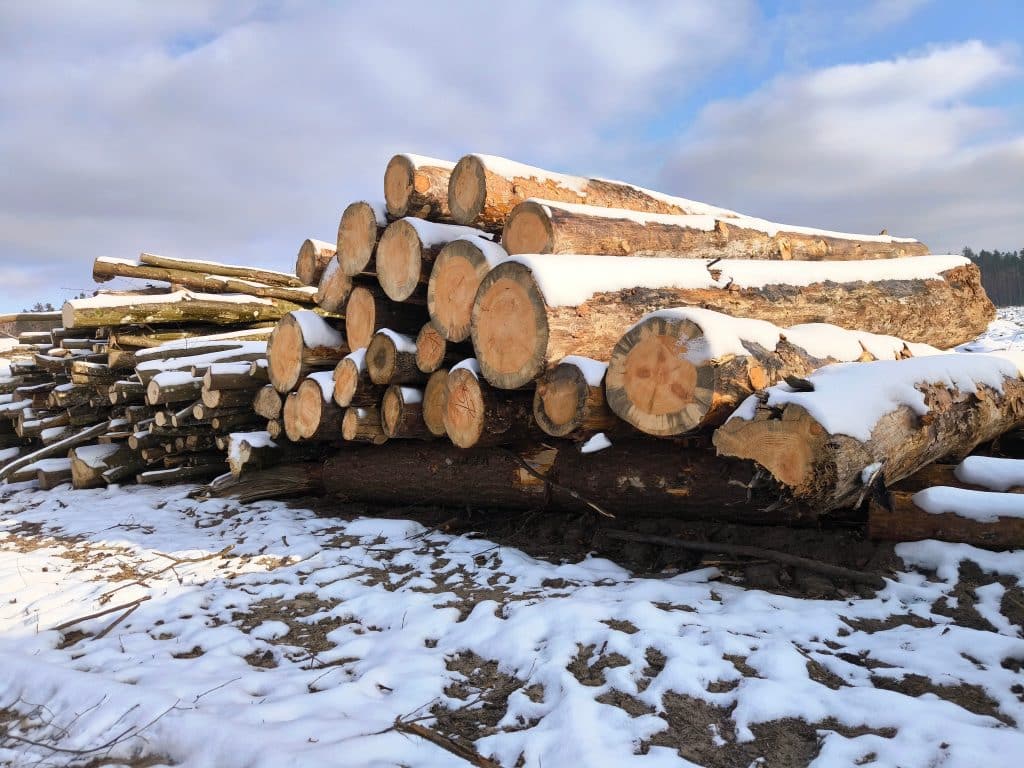
Wood is the only major building material that grows naturally and is renewable. With growing pressure to reduce the carbon footprint of the built environment, building designers are increasingly being called upon to balance function and cost objectives of a building with reduced environmental impact. Wood can help to achieve that balance. Numerous life cycle assessment studies worldwide have shown that wood products yield clear environmental advantages over other building materials at every stage. Wood buildings can offer lower greenhouse gas emissions, less air pollution, lower volumes of solid waste and less ecological resource use.
Energy Efficiency
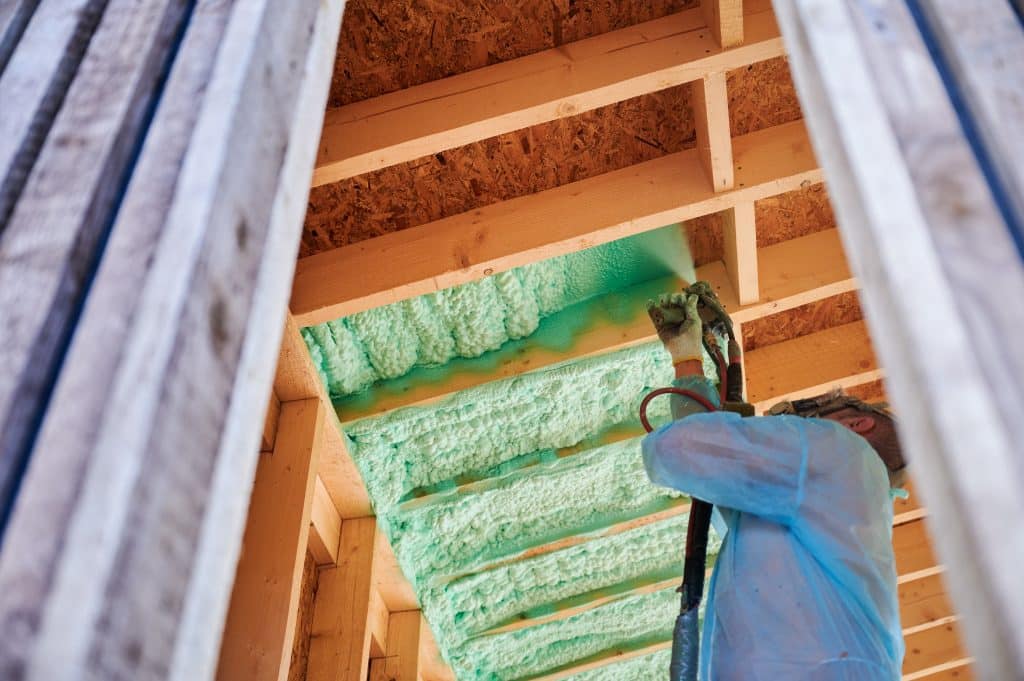
Of all the energy used in North America, it is estimated that 30 to 40 percent is consumed by buildings. In Canada, the majority of operational energy in residential buildings is provided by natural gas, fuel oil, or electricity, and is consumed for space heating. Given the fact that buildings are a significant source of energy consumption and greenhouse gas emissions in Canada, energy efficiency in the buildings sector is essential to address climate change mitigation targets. As outlined in the Pan-Canadian Framework on Clean Growth and Climate Change, the federal, provincial and territorial governments are committed to investment in initiatives to support energy efficient homes and buildings as well as energy benchmarking and labelling programs. Despite the expanding number of choices for consumers, the most cost-effective way to increase building energy performance has remained unchanged over the decades: • maximize the thermal performance of the building envelope by adding more insulation and reducing thermal bridging; and • increase the airtightness of the building envelope. The building envelope is commonly defined as the collection of components that separate conditioned space from unconditioned space (exterior air or ground). The thermal performance and airtightness of the building envelope (also known as the building enclosure) effects the whole-building energy efficiency and significantly affects the amount of heat losses and gains. Building and energy codes and standards within Canada have undergone or are currently undergoing revisions, and the minimum thermal performance requirements for wood-frame building enclosure assemblies are now more stringent. The most energy efficient buildings are made with materials that resist heat flow and are constructed with accuracy to make the best use of insulation and air barriers. To maximize energy efficiency, exterior wall and roof assemblies must be designed using framing materials that resist heat flow, and must include continuous air barriers, insulation materials, and weather barriers to prevent air leakage through the building envelope. The resistance to heat flow of building envelope assemblies depends on the characteristics of the materials used. Insulated assemblies are not usually homogeneous throughout the building envelope. In light-frame walls or roofs, the framing members occur at regular intervals, and, at these locations, there is a different rate of heat transfer than in the spaces between the framing members. The framing members reduce the thermal resistance of the overall wall or ceiling assembly. The rate of heat transfer at the location of framing elements depends on the thermal or insulating properties of the structural framing material. The higher rate of heat transfer at the location of framing members is called thermal bridging. The framing members of a wall or roof can account for 20 percent or more of the surface area of an exterior wall or roof and since the thermal performance of the overall assembly depends on the combined effect of the framing and insulation, the thermal properties of the framing materials can have a significant effect on the overall (effective) thermal resistance of the assembly. Wood is a natural thermal insulator due to the millions of tiny air pockets within its cellular structure. Since thermal conductivity increases with relative density, wood is a better insulator than dense construction materials. With respect to thermal performance, wood-frame building enclosures are inherently more efficient than other common construction materials, largely because of reduced thermal bridging through the wood structural elements, including the wood studs, columns, beams, and floors. Wood loses less heat through conduction than other building materials and wood-frame construction techniques support a wide range of insulation options, including stud cavity insulation and exterior rigid insulation. Research and monitoring of buildings is increasingly demonstrating the importance of reducing thermal bridging in new construction and reducing thermal bridges in existing buildings. The impact of thermal bridges can be a significant contributor to whole building energy use, the risk of condensation on cold surfaces, and occupant comfort. Focusing on the building envelope and ventilation at the time of construction makes sense, as it is difficult to make changes to these systems in the future. High performance buildings typically cost more to build than conventional construction, but the higher purchase price is offset, at least in part, by lower energy consumption costs over the life cycle. What’s more, high performance buildings are often of higher quality and more comfortable to live and work in. Making buildings more energy efficient has also been shown to be one of the lowest cost opportunities to contribute to energy reduction and climate change mitigation goals. Several certification and labeling programs are available to builders and consumers address reductions in energy consumption within buildings. Natural Resources Canada (NRCan) administers the R-2000 program, which aims to reduce home energy requirements by 50 percent compared to a code-built home. Another program administered by NRCan, ENERGY STAR®, aims to be 20 to 25 percent more energy efficient than code. The EnerGuide Rating System estimates the energy performance of a house and can be used for both existing homes and in the planning phase for new construction. Other certification programs and labelling systems have fixed performance targets. Passive House is a rigorous standard for energy efficiency in buildings to reduce the energy use and enhance overall performance. The space heating load must be less than 15 kWh/m2 and the airtightness must be less than 0.6 air changes per hour at 50 Pa, resulting in ultra-low energy buildings that require up to 90 percent less heating and cooling energy than conventional buildings. The NetZero Energy Building Certification, a program operated by the International Living Future Institute, is a performance-based program and requires that the building have net-zero energy consumption for twelve consecutive months. Green Globes and Leadership in Energy and Environmental Design (LEED) are additional building rating systems that are prevalent in the building design and construction marketplace. For further information, refer to the following resources: Thermal Performance of Light-Frame Assemblies – IBS No.5 (Canadian Wood Council) National Energy Code of Canada for Buildings Natural Resources Canada BC Housing Passive House Canada Green Globes Canadian Green Building Council
Climate Change

Concerns about climate change are encouraging decarbonization of the building sector, including the use of construction materials responsible for fewer greenhouse gas (GHG) emissions and improvements in operational performance over the life cycle of buildings. Accounting for over 10 percent of total GHG emissions in Canada, the building sector plays an important role in climate change mitigation and adaptation. Decreasing the climate change impacts of buildings offers high environmental returns for relatively low economic investment. The Government of Canada, as a signatory to the Paris Agreement, has committed to reducing Canada’s GHG emissions by 30 percent below 2005 levels by 2030. In addition, the Pan-Canadian Framework on Clean Growth and Climate Change acknowledges that forest and wood products have the ability to contribute to the national emissions reductions strategy through: enhancing carbon storage in forests; increasing the use of wood for construction; generating fuel from bioenergy and bioproducts; and advancing innovation in bio-based product development and forest management practices. The importance of the forestry and wood products sector as a critical component toward mitigating the effects of climate change is also echoed by the Intergovernmental Panel on Climate Change (IPCC); stating that a sustainable forest management strategy aimed at maintaining or increasing forest carbon stocks while producing timber, fibre, or energy, generates the largest sustained benefit to mitigate climate change. In addition, the IPCC proclaims that “mitigating options by the forest sector include extending carbon retention in HWP [harvested wood products], product substitution, and producing biomass for bioenergy.” The Canadian forest industry is pledging to remove 30 megatons of carbon dioxide (CO2) a year by 2030, equivalent to 13 percent of Canada’s national commitments under the Paris Agreement. Several mechanisms will be employed to meet this challenge, including: product displacement, using bio-based products in place of fossil fuel-derived products and energy sources; forest management practices, including increased utilization, improved residue use and land use planning, and better growth and yields; accounting for long-lived bio-based product carbon pools; and higher efficiencies in wood product manufacturing processes Canada is home to 9 percent of the world’s forests, which have the ability to act as enormous carbon sinks by absorbing and storing carbon. Annually, Canada harvests less than one-half of one percent of its forest land, allowing for the forest cover in Canada to remain constant for last century. Sustainable forest management and legal requirements for reforestation continue to maintain this vast carbon reservoir. A forest is a natural system that is considered carbon neutral as long as it is managed sustainably, which means it must be reforested after harvest and not converted to other land uses. Canada has some of the strictest forest management regulations in the world, requiring successful regeneration after public forests are harvested. When managed with stewardship, forests are a renewable resource that will be available for future generations. Canada is also a world leader in voluntary third-party forest certification, adding further assurance of sustainable forest management. Sustainable forest management programs and certification schemes strive to preserve the quantity and quality of forests for future generations, respect the biological diversity of the forests and the ecology of the species living within it, and respect the communities affected by the forests. Canadian companies have achieved third-party certification on over 150 million hectares (370 million acres) of forests, the largest area of certified forests in the world. The forest represents one carbon pool, storing biogenic carbon in soils and trees. The carbon remains stored until the trees die and decay or burn. When a tree is cut, 40 to 60 percent of the biogenic carbon remains in the forest; the rest is removed as logs and much of it is transferred to the wood products carbon pool within the built environment. Wood products continue to store this biogenic carbon, often for decades in the case of wood buildings, delaying or preventing the release of CO2 emissions. Wood products and building systems have ability to store large amounts of carbon; 1 m3 of S-P-F lumber stores approximately 1 tonne of CO2 equivalent. The amount of carbon stored within a wood product is directly proportional the density of the wood. The average single-family home in Canada stores almost 30 tonnes of CO2 equivalent within the wood products used for its construction. Most bio-based construction products actually store more carbon in the wood fibre than is released during the harvesting, manufacturing and transportation stages of their life cycle. In general, bio-based products like wood that are naturally grown with help from the sun have lower embodied emissions. The embodied emissions arise through the production processes of building materials, starting with resource extraction or harvesting through manufacturing, transportation, construction, and end-of-life. Bioenergy produced from bio-based residuals, such as tree bark and sawdust, is primarily used to generate energy for the manufacture of wood products in North America. Wood construction products have low embodied GHG emissions because they are grown using renewable solar energy, use little fossil fuel energy during manufacturing, and have many end-of-life options (reuse, recycle, energy recovery). Wood products have the ability to substitute for other more carbon-intensive building materials and energy sources. GHG emissions are thereby avoided by using wood products instead of other more GHG-intensive building products. Displacement factors (kg CO2 avoided per kg wood used) have been estimated to calculate the amount of carbon avoided through the use of wood products in building construction. For further information, refer to the following resources: Addressing Climate Change in the Building Sector – Carbon Emissions Reductions (Canadian Wood Council) Resilient and Adaptive Design Using Wood (Canadian Wood Council) CWC Carbon Calculator Canada’s Forest Products Industry “30 by 30” Climate Change Challenge (Forest Products Association of Canada) www.naturallywood.com www.thinkwood.com Building with wood = Proactive climate protection (Binational Softwood Lumber Council and State University of New York) Natural Resources Canada Pan-Canadian Framework on Clean Growth and Climate Change (Government of Canada) Intergovernmental Panel on Climate Change
Life Cycle Assessment
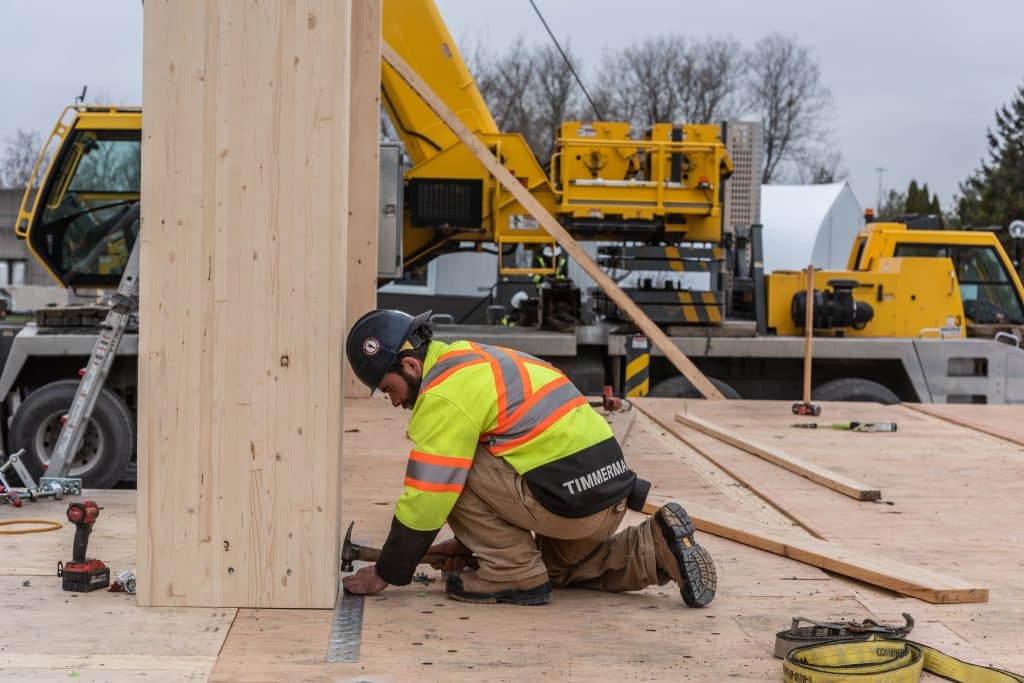
Construction products and the building sector as a whole have significant impacts on the environment. Policy instruments and market forces are increasingly pushing governments and businesses to document and report environmental impacts and track improvements. One tool that is available to help understand the environmental aspects related to new construction, renovation, and retrofits of buildings and civil engineering works is life cycle assessment (LCA). LCA is a decision-making tool that can help to identify design and construction approaches that yield improved environmental performance. Several European jurisdictions, including Germany, Zurich and Brussels, have made LCA a mandatory requirement prior to issuing a building permit. In addition, the application of LCA to building design and materials selection is a component of green building rating systems. LCA can benefit manufacturers, architects, builders, and government agencies by providing quantitative information about potential environmental impacts and providing data to identify areas for improvement. LCA is a performance-based approach to assessing the environmental aspects related to building design and construction. LCA can be used to understand the potential environmental impacts of a product or structure at every stage of its life; from resource extraction or raw material acquisition, transportation, processing and manufacturing, construction, operation, maintenance and renovation to the end-of-life. LCA is an internationally accepted, science-based methodology which has existed in alternative forms since the 1960s. The requirements and guidance for conducting LCA has been established through international consensus standards; ISO 14040 and ISO 14044. LCA considers all input and output flows (materials, energy, resources) associated with a given product system and is an iterative procedure that includes goal and scope definition, inventory analysis, impact assessment, and interpretation. The inventory analysis, also known as the life cycle inventory (LCI), consists of data collection and the tracking of all input and output flows within a product system. Publicly available LCI databases, such as the U.S. Life Cycle Inventory Database, are accessible free of charge in order to source this LCI data. During the impact assessment phase of the LCA, the LCI flows are translated into potential environmental impact categories using theoretical and empirical environmental modelling techniques. LCA is able to quantify potential environmental impacts and aspects of a product, such as: Global warming potential; Acidification potential; Eutrophication potential; Ozone depletion potential; Smog potential; Primary energy consumption; Material resources consumption; and Hazardous and non-hazardous waste generation. LCA tools are available to building designers that are publicly accessible and user friendly. These tools allow designers to rapidly obtain potential environmental impact information for an extensive range of generic building assemblies or develop full building life cycle assessments on their own. LCA software offers building professionals powerful tools for calculating the potential life cycle impacts of building products or assemblies and performing environmental comparisons. It is also possible to use LCA to perform objective comparisons between alternate materials, assemblies and whole buildings, measured over the respective life cycles and based on quantifiable environmental indicators. LCA enables comparison of the environmental trade-offs associated with choosing one material or design solution over another and, as a result, provides an effective basis for comparing relative environmental implications of alternative building design scenarios. An LCA that examines alternative design options must ensure functional equivalence. Each design scenario considered, including the whole building, must meet building code requirements and offer a minimum level of technical performance or functional equivalence. For something as complex as a building, this means tracking and tallying the environmental inputs and outputs for the multitude of assemblies, subassemblies and components in each design option. The longevity of a building system also impacts the environmental performance. Wood buildings can remain in service for long periods of time if they are designed, built and maintained properly. Numerous LCA studies worldwide have demonstrated that wood building products and systems can yield environmental advantages over other building materials and methods of construction. FPInnovations conducted a LCA of a four-storey building in Quebec constructed using cross-laminated timber (CLT). The study assessed how the CLT design would compare with a functionally equivalent concrete and steel building of the same floor area, and found improved environmental performance in two of six impact categories, and equivalent performance in the rest. In addition, at the end-of-life, bio-based products have the ability to become part of a subsequent product system when reused, recycled or recovered for energy; potentially reducing environmental impacts and contributing to the circular economy. Life cycle of wood construction products Photo source: CEI-Bois For further information, refer to the following resources: www.naturallywood.com Athena Sustainable Materials Institute Building for Environmental and Economic Sustainability (BEES) FPInnovations. A Comparative Life Cycle Assessment of Two Multistory Residential Buildings: Cross-Laminated Timber vs. Concrete Slab and Column with Light Gauge Steel Walls, 2013. American Wood Council U.S. Life Cycle Inventory Database ISO 14040 Environmental management – Life cycle assessment – Principles and framework ISO 14044 Environmental management – Life cycle assessment – Requirements and guidelines
Codes & Standards
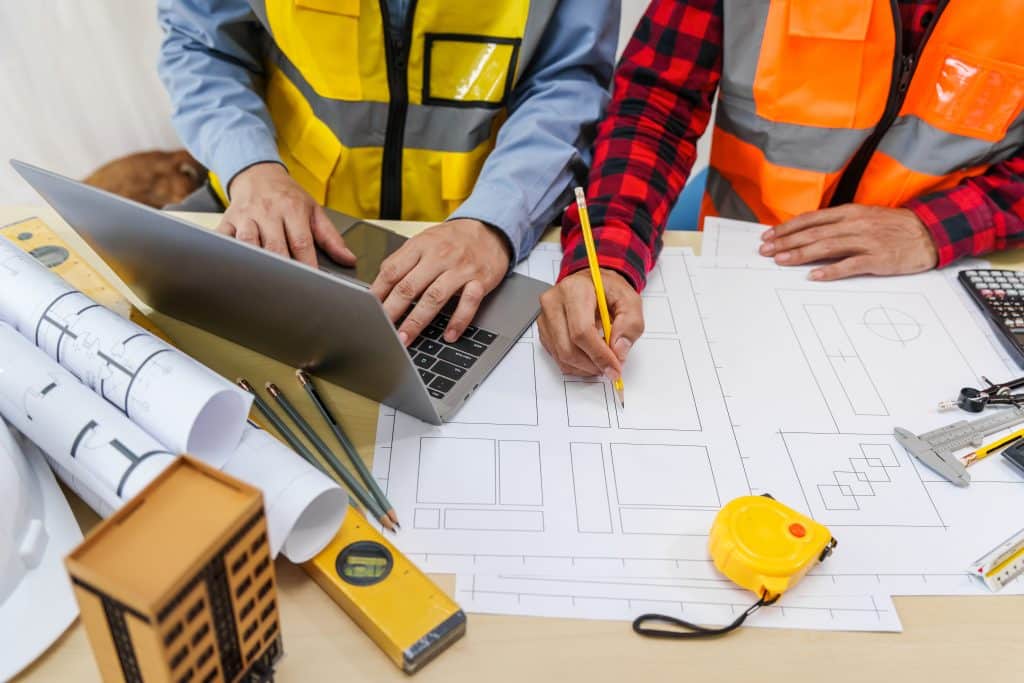
BUILDING CODES & STANDARDS (THE REGULATORY SYSTEM) The construction industry is regulated through building codes which are informed by: Design standards that provide information on “how to” build with wood, Product standards that define the characteristics of the wood products that can be used in design standards, and Test standards that set out the methodology for establishing a wood product’s characteristics CWC is active in a technical capacity in all areas of the Regulatory System. This includes: BUILDING CODES – CWC participates extensively in the development process of the Building Codes in Canada. CWC is a member of both National and Provincial Building Code Committees. These Committees are balanced and representation is limited to about 25 members on each Committee. Competing interests (i.e. steel and concrete) sit on the same Committees. This is an arena where CWC can win or lose ground for members’ products. DESIGN STANDARDS – Each producer of structural materials develops engineering design standards that provide information on how to use their products in buildings. CWC holds the Secretariat for Canada’s wood design standard (CSA O86 “Engineering Design in Wood”), providing both technical expertise and administrative support for its development. CWC is also a member of the American Wood Council (AWC) committee that is responsible for the U.S. National Design Specification for wood design. PRODUCT STANDARDS – CWC is involved in the development of Canadian, U.S. and international standards for its wood building product producers. TEST STANDARDS – CWC is involved in developing Canadian, U.S. and international test standards in areas that affect wood products, such as fire performance. Detailed building codes & standards pages: Acoustics Combustible construction Encapsulated mass timber construction Energy Code National Fire Code National Model Codes in Canada Wood design in the National Building Code of Canada Wood in non-combustible buildings Wood Standards CSA O86 Engineering design in wood CSA S-6 Canadian Highway Bridge Design Code CSA S406 Permanent Wood Foundations CSA 080 Wood Preservation
Fire Code
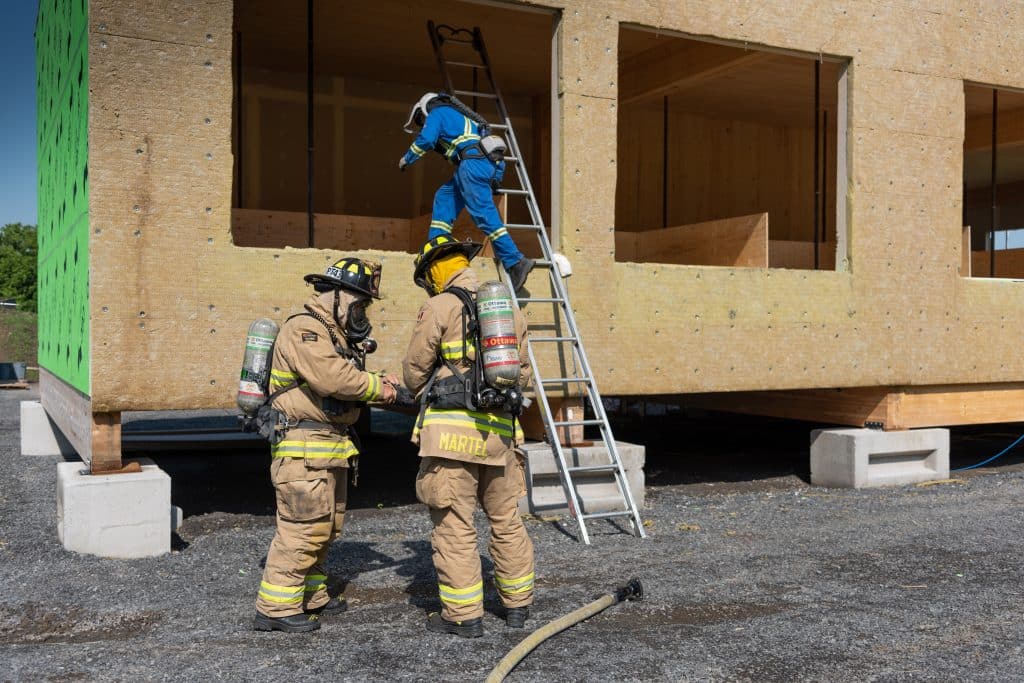
National Fire Code of Canada The National Building Code of Canada (NBC) and the National Fire Code of Canada (NFC), both published by the National Research Council of Canada (NRC) and developed by the Canadian Commission on Building and Fire Codes (CCBFC), are developed as companion documents. The NBC establishes minimum standards for the health and safety of the occupants of new buildings. It also applies to the alteration of existing buildings, including changes in occupancy. The NBC is not retroactive. That is, a building constructed in conformance with a particular edition of the NBC, which is in effect at the time of its construction, is not automatically required to conform to the subsequent edition of the NBC. That building would only be required to conform to an updated version of the NBC if it were to undergo a change in occupancy or alterations which invoke the application of the new NBC in effect at the time of the change in occupancy or major alteration. The NFC addresses fire safety during the operation of facilities and buildings. The requirements in the NFC, on the other hand, are intended to ensure the level of safety initially provided by the NBC is maintained. With this objective, the NFC regulates: the conduct of activities causing fire hazards the maintenance of fire safety equipment and egress facilities limitations on building content, including the storage and handling of hazardous products the establishment of fire safety plans The NFC is intended to be retroactive with respect to fire alarm, standpipe and sprinkler systems. In 1990, the NFC was revised to clarify that such systems “shall be provided in all buildings where required by and in conformance with the requirements of the National Building Code of Canada.” This ensures that buildings are adequately protected against the inherent risk at the same level as the NBC would require for a new building. It does not concern other fire protection features such as smoke control measures or firefighter’s elevators. The NFC also ensures that changes in building use do not increase the risk beyond the limits of the original fire protection systems. The NBC and the NFC are written to minimize the possibility of conflict in their respective contents. Both must be considered when constructing, renovating or maintaining buildings. They are complementary, in that the NFC takes over from the NBC once the building is in operation. In addition, older structures which do not conform to the most current level of fire safety can be made safer through the requirements of the NFC. The most recent significant changes in the NFC relate the construction of six-storey buildings using combustible construction. As a result, eight additional protection measures related to mid-rise combustible buildings have been added to address fire hazards during construction when fire protection features are not yet in place.
Energy Code
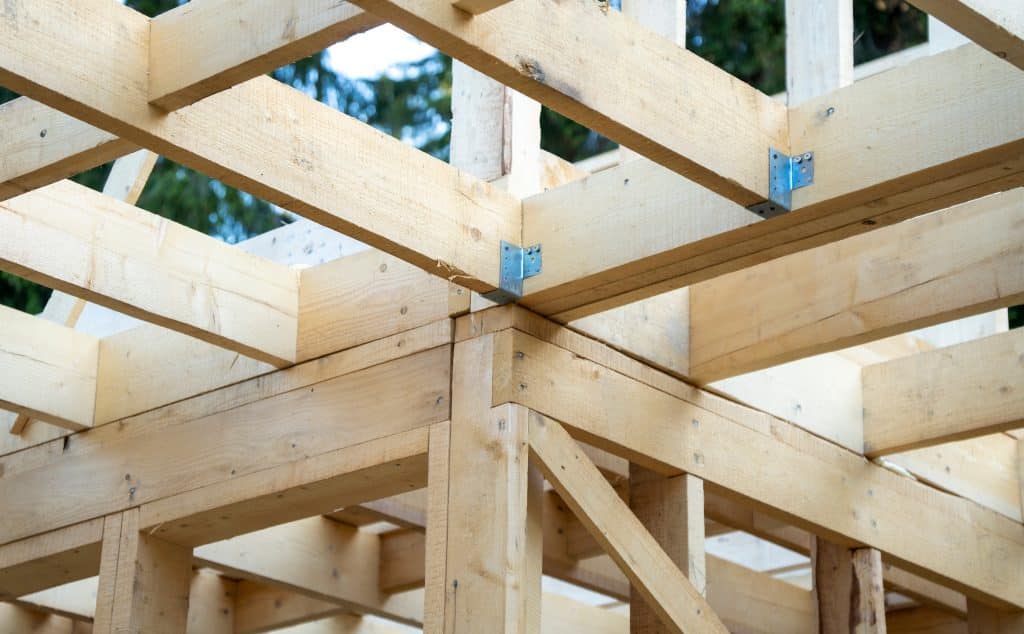
The National Energy Code of Canada for Buildings (NECB) aims to help save on energy bills, reduce peak energy demand, and improve the quality and comfort of the building’s indoor environment. Through each code development cycle, the NECB intends to implement a tiered approach toward Canada’s goal for new buildings, as presented in the “Pan-Canadian Framework on Clean Growth and Climate Change”, of achieving ‘Net Zero Energy Ready’ buildings by 2030. The NECB is available for free online; published by the National Research Council (NRC) and developed by the Canadian Commission on Building and Fire Codes in collaboration with Natural Resources Canada (NRCan). CWC maintains ongoing participation in the development and updating of the NECB. The NECB sets out technical requirements for energy efficient design and construction and outlines the minimum energy efficiency levels for code compliance of all new buildings. The NECB applies to all building types, except housing and small buildings, which are addressed under Clause 9.36 of the National Building Code of Canada. The NECB offers three compliance paths: prescriptive, trade-off and performance. The most cost-effective time to incorporate energy efficiency measures into a building is during the initial design and construction phase. It is much more expensive to retrofit later. This is particularly true for the building envelope, which includes exterior walls, windows, doors and roofing. The NECB addresses considerations such as air infiltration rates (air leakage) and thermal transmission of heat through the building envelope. Considering the different climate zones in Canada, the NECB also provides requirements related to maximum overall (effective) thermal transmittance for above-ground opaque wall assemblies and effective thermal resistance of assemblies in contact with ground, e.g., permanent wood foundations. In addition, the NECB specifies the maximum fenestration and door to wall ratio based on the climate zone in which the building in located. As energy efficiency requirements for buildings are increased, wood is a natural solution to pair with other insulating and weatherizing materials to develop buildings with high operational energy performance and provide consistent indoor comfort for occupants. For further information on the NECB, visit the Codes Canada at the National Research Council Canada.
Acoustics

Wood is composed of many small cellular tubes that are predominantly filled with air. The natural composition of the material allows for wood to act as an effective acoustical insulator and provides it with the ability to dampen vibrations. These sound-dampening characteristics allow for wood construction elements to be specified where sound insulation or amplification is required, such as libraries and auditoriums. Another important acoustical property of wood is its ability to limit impact noise transmission, an issue commonly associated with harder, more dense materials and construction systems. The use of topping or a built-up floating floor system overlaid on light wood frame or mass timber structural elements is a common approach to address acoustic separation between floors of a building. Depending on the type of materials in the built-up floor system, the topping can be applied directly to the wood structural members or over top of a moisture barrier or resilient layer. The use of gypsum board, absorptive (batt/loose-fill) insulation and resilient channels are also critical components of a wood-frame wall or floor assembly that also contribute to the acoustical performance of the overall assembly. Acoustic design considers a number of factors, including building location and orientation, as well as the insulation or separation of noise-producing functions and building elements. Sound Transmission Class (STC), Apparent Sound Transmission Class (ASTC) and Impact Insulation Class (IIC) ratings are used to establish the level of acoustic performance of building products and systems. The different ratings can be determined on the basis of standardized laboratory testing or, in the case of ASTC ratings, calculated using methodologies described in the NBC. Currently, the National Building Code of Canada (NBC) only regulates the acoustical design of interior wall and floor assemblies that separate dwelling units (e.g. apartments, houses, hotel rooms) from other units or other spaces in a building. The STC rating requirements for interior wall and floor assemblies are intended to limit the transmission of airborne noise between spaces. The NBC does not mandate any requirements for the control of impact noise transmission through floor assemblies. Footsteps and other impacts can cause severe annoyance in multifamily residences. Builders concerned about quality and reducing occupant complaints will ensure that floors are designed to minimize impact transmission. Beyond conforming to the minimum requirements of the NBC in residential occupancies, designers can also establish acoustic ratings for design of non-residential projects and specify materials and systems to ensure the building performs at that level. In addition to limiting transmission of airborne noise through internal structural walls and floors, flanking transmission of sound through perimeter joints and sound transmission through non-structural partition walls should also be considered during the acoustical design. Further information and requirements related to STC, ASTC and IIC ratings are provided in Appendix A of the NBC in sections A-9.10.3.1. and A-9.11.. This includes, inter alia, Tables 9.10.3.1-A and 9.10.3.1.-B that provide generic data on the STC ratings of different types of wood stud walls and STC and IIC ratings for different types of wood floor assemblies, respectively. Tables A-9.11.1.4.-A to A-9.11.1.4.-D present generic options for the design and construction of junctions between separating and flanking assemblies. Constructing according to these options is likely to meet or exceed an ASTC rating of 47 that is mandated by the NBC. Table A-Table 9.11.1.4. presents data about generic floor treatments that can be used to improve the flanking sound insulation performance of lightweight framed floors, i.e., additional layers of material over the subfloor (e.g. concrete topping, OSB or plywood) and finished flooring or coverings (e.g., carpet, engineered wood).
Combustible construction
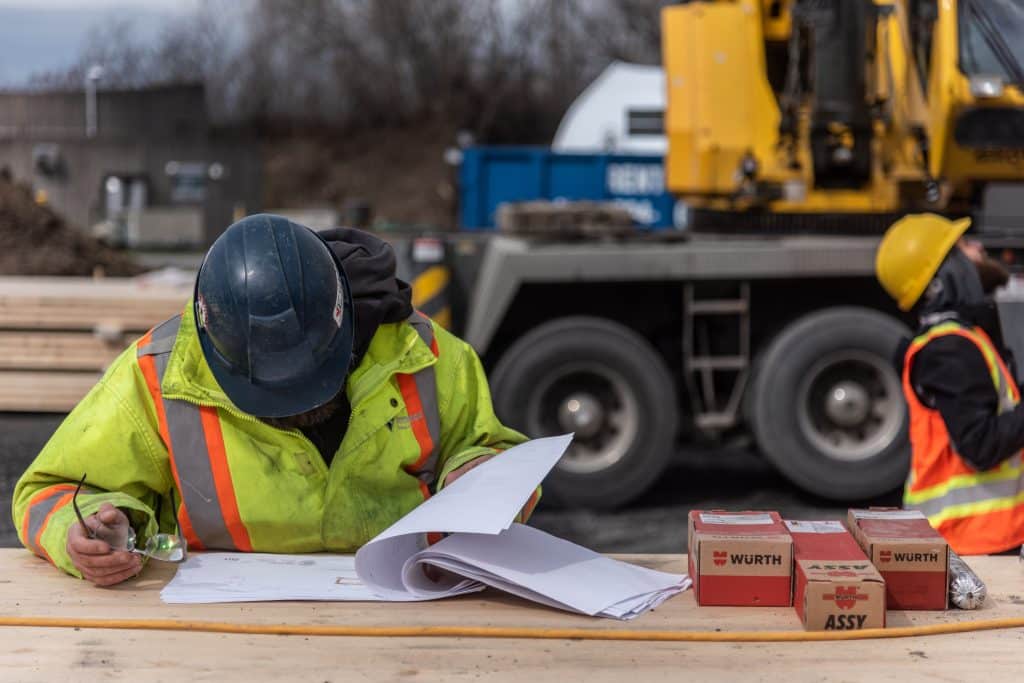
The provision of fire safety in a building is a complex matter; far more complex than the relative combustibility of the main structural materials used in a building. To develop safe code provisions, prevention, suppression, movement of occupants, mobility of occupants, building use, and fuel control are but a few of the factors that must be considered in addition to the combustibility of the structural components. Fire-loss experience shows that building contents play a large role in terms of fuel load and smoke generation potential in a fire. The passive fire protection provided by the fire-resistance ratings on the floor and wall assemblies in a building assures structural stability in a fire. However, the fire-resistance rating of the structural assemblies does not necessarily control the movement of smoke and heat, which can have a large impact on the level of safety and property damage resulting from fire. The National Building Code of Canada (NBC) categorizes wood buildings as ‘combustible construction’. Despite being termed combustible, common construction techniques can give wood frame construction fire-resistance ratings up to two hours. When designed and built to code requirements, wood buildings provide the same level of life safety and property protection required for comparably sized buildings defined under the NBC as ‘noncombustible construction’. Wood has been used for virtually all types of buildings, including; schools, warehouses, fire stations, apartment buildings, and research facilities. The NBC sets out guidelines for the use of wood in applications that extend well beyond the traditional residential and small building sector. The NBC allows wood construction of up to six storeys in height, and wood cladding for buildings designated to be of noncombustible construction. When meeting the area and height limits for the various NBC building categories, wood frame construction can meet the life safety requirements by making use of wood-frame assemblies (usually protected by gypsum wallboard) that are tested for fire-resistance ratings. The allowable height and area restrictions can be extended by using fire walls to break a large building area into smaller separate building areas. The recognized positive contribution to both life safety and property protection which comes from the use of automatic sprinkler systems can also be used to increase the permissible area of wood buildings. Sprinklers typically operate very early in a fire thereby quickly controlling the damaging effects. For this reason, the provision of automatic sprinkler protection within a building greatly improves the life safety and property protection prospects of all buildings including those constructed of noncombustible materials. The NBC permits the use of ‘heavy timber construction’ in buildings where combustible construction is required to have a 45-minute fire-resistance rating. This form of heavy timber construction is also permitted to be used in large noncombustible buildings in certain occupancies. To be acceptable, the components must comply with minimum dimension and installation requirements. Heavy timber construction is afforded this recognition because of its performance record under actual fire exposure and its acceptance as a fire-safe method of construction. In sprinklered buildings permitted to be of combustible construction, no fire-resistance rating is required for the roof assembly or its supports when constructed from heavy timber. In these cases, a heavy timber roof assembly and its supports would not have to conform to the minimum member dimensions stipulated in the NBC. Mass timber elements may also be used whenever combustible construction is permitted. In those instances, however, such mass timber elements need to be specifically designed to meet any required fire-resistance ratings. NBC definitions: Combustible means that a material fails to meet the acceptance criteria of CAN/ULC-S114, “Test for Determination of Non-Combustibility in Building Materials.” Combustible construction means that type of construction that does not meet the requirements for noncombustible construction. Heavy timber construction means that type of combustible construction in which a degree of fire safety is attained by placing limitations on the sizes of wood structural members and on thickness and composition of wood floors and roofs and by the avoidance of concealed spaces under floors and roofs. Noncombustible construction means that type of construction in which a degree of fire safety is attained by the use of noncombustible materials for structural members and other building assemblies. Noncombustible means that a material meets the acceptance criteria of CAN/ULC-S114, “Test for Determination of Non-Combustibility in Building Materials.” For further information, refer to the following resources: National Building Code of Canada CAN/ULC-S114 Test for Determination of Non-Combustibility in Building Materials Wood Design Manual 2017
Encapsulated mass timber construction
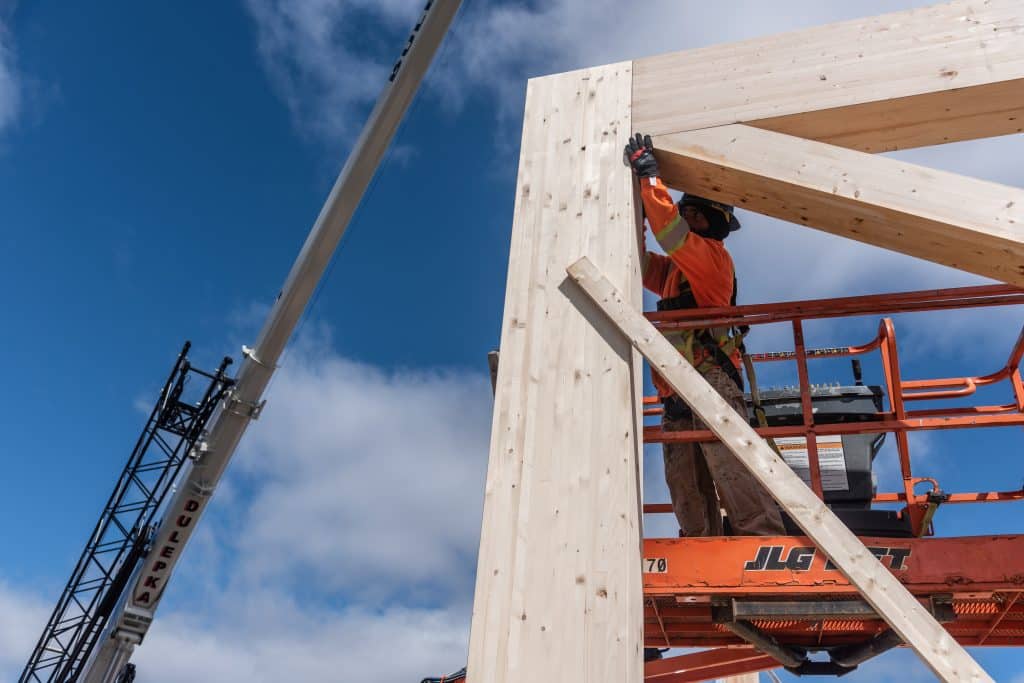
In addition to combustible, heavy timber and noncombustible construction, a new construction type is presently being considered for inclusion into the National Building Code of Canada (NBC). Encapsulated mass timber construction (EMTC) is proposed to be defined as the “type of construction in which a degree of fire safety is attained by the use of encapsulated mass timber elements with an encapsulation rating and minimum dimensions for the structural timber members and other building assemblies.” EMTC is neither ‘combustible construction’ nor ‘heavy timber construction’ nor ‘noncombustible construction’, as defined within the NBC. EMTC is required to have an encapsulation rating. The encapsulation rating is the time, in minutes, that a material or assembly of materials will delay the ignition and combustion of encapsulated mass timber elements when it is exposed to fire under specified conditions of test and performance criteria, or as otherwise prescribed by the NBC. The encapsulation rating for EMTC is determined through the ULC S146 test method. In order for structural wood elements to be considered ‘mass timber’, they must meet minimum size requirements, which are different for horizontal (walls, floors, roofs, beams) and vertical (columns, arches) load-bearing elements and dependent on the number of sides that the element is exposed to fire. EMTC construction in Canada is expected to be limited to a height of twelve-storeys, that is, the uppermost floor level may be a maximum of 42 m (137 ft) above the first floor. An EMTC building must be sprinklered throughout according to NFPA 13 and it is likely that some mass timber will also be able to be exposed in the suites. All EMTC elements are expected to have a minimum two-hour fire resistance rating and the building floor area to be limited to 6,000 m2 for Group C occupancy and 7,200 m2 for Group D occupancy. There are restrictions on the use of exterior cladding elements in EMTC, as well as other restrictions on the use of; combustible roofing materials, combustible window sashes and frames, combustible components in exterior walls, nailing elements, combustible flooring elements, combustible stairs, combustible interior finishes, combustible elements in partitions, and concealed spaces. If any encapsulation material is damaged or removed, it will be required to be repaired or replaced so that the encapsulation rating of the materials is maintained. Additionally, requirements related to construction site fire safety are to be applied to construction access, standpipe installation and protective encapsulation. EMTC and its related provisions are anticipated to be included in the NBC 2020. NBC definitions: Combustible means that a material fails to meet the acceptance criteria of CAN/ULC-S114, “Test for Determination of Non-Combustibility in Building Materials.” Combustible construction means that type of construction that does not meet the requirements for noncombustible construction. Heavy timber construction means that type of combustible construction in which a degree of fire safety is attained by placing limitations on the sizes of wood structural members and on thickness and composition of wood floors and roofs and by the avoidance of concealed spaces under floors and roofs. Noncombustible construction means that type of construction in which a degree of fire safety is attained by the use of noncombustible materials for structural members and other building assemblies. Noncombustible means that a material meets the acceptance criteria of CAN/ULC-S114, “Test for Determination of Non-Combustibility in Building Materials.” For further information, refer to the following resources: Guide to Encapsulated Mass Timber Construction in the Ontario Building Code ULC S146 Standard Method of Test for the Evaluation of Encapsulation Materials and Assemblies of Materials for the Protection of Mass Timber Structural Members and Assemblies Fire performance of mass-timber encapsulation methods and the effect of encapsulation on char rate of cross-laminated timber (Hasburgh et al., 2016) CAN/ULC-S114 Test for Determination of Non-Combustibility in Building Materials NFPA 13 Standard for the Installation of Sprinkler Systems
Fire Safety
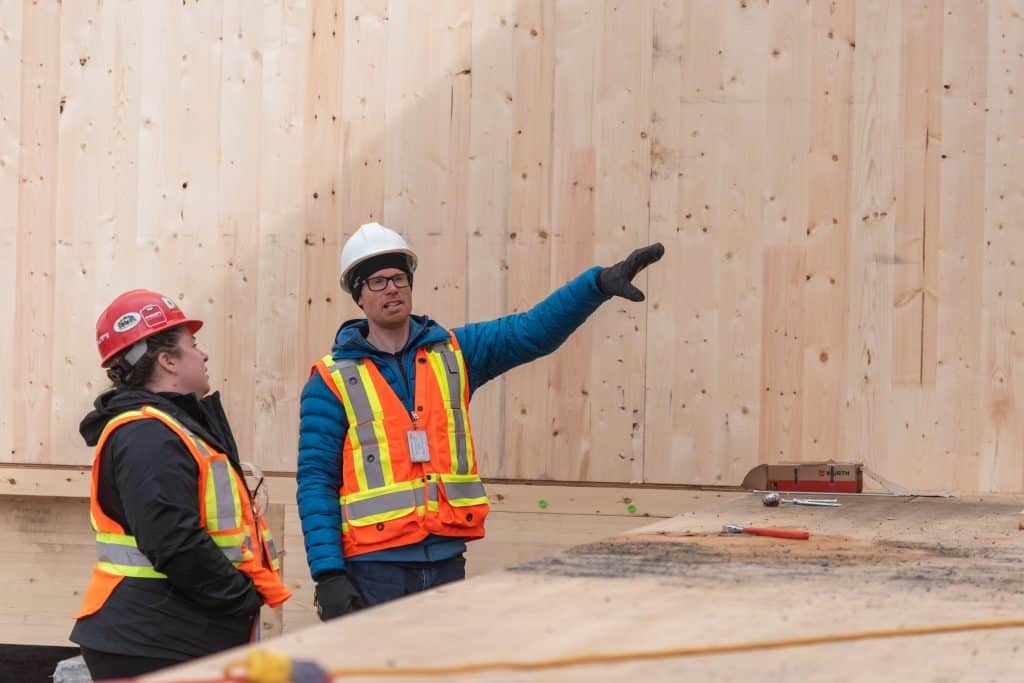
The National Building Code of Canada (NBC) defines fire safety under Objective OS1: “an objective of this code is to limit the probability that as a result of the design or construction of the building, a person in or adjacent to a building will be exposed to an unacceptable risk of injury due to fire.” In simpler terms, fire safety is the reduction of the potential for harm to life as a result of fire in buildings. Although the potential for being killed or injured in a fire cannot be completely eliminated, fire safety in a building can be achieved through proven building design features intended to minimize the risk of harm to people from fire to the greatest extent possible. Designing a building to ensure minimal risk or to meet a prescribed level of safety from fire is more complex than just the simple consideration of what building materials will be used in construction of the building, since all building materials are affected by fire. Many factors must be considered including the use of the building, the number of occupants, how easily they can exit the building in case of a fire and how a fire can be contained. Even materials that do not sustain fire do not guarantee the safety of a structure. Steel, for instance, quickly loses its strength when heated and its yield point decreases significantly as it absorbs heat, endangering the stability of the structure. An unprotected, conventional cold-formed steel joist floor system will fail in less than 10 minutes under standard laboratory fire exposure test methods, while an unprotected, conventional wood joist floor system can last up to 15 minutes. Reinforced concrete is also not immune to fire. Concrete will spall under elevated temperatures, exposing the steel reinforcement and weakening structural members. As a result, it is generally recognized that there is really no such thing as a fire-proof building. The NBC only regulates those elements which are part of the building construction. The building contents found in any building are typically not regulated by the NBC, but in some cases they are regulated by the National Fire Code of Canada (NFC). The occupancy classification of buildings or parts of buildings according to their intended use accounts for: the quantity and type of combustible contents likely to be present (potential fire load); the number of persons likely to be exposed to the threat of fire; the area of the building; and the height of the building. This occupancy classification is the starting point in determining which fire safety requirements apply to a particular building. The occupancy classification of a building within the NBC dictates: the type of building construction; the level of fire protection; and the degree of structural protection against fire spread between parts of a building that are used for different purposes. Fires can occur in any type of structure. The severity of a fire, however, is contingent on the ability of a construction to: confine the fire; limit a fire’s effects on the supporting structure; and control the spread of smoke and gases. To varying degrees, any type of construction can be designed as a system (combination of construction assemblies) to limit the effects of fire. This allows occupants sufficient time to escape the building and for firefighters to safely carry out their duties. Occupant safety also depends on other parameters such as detection, exit paths, and the use of automatic fire suppression systems such as sprinklers. These concepts form the basis of the NBC requirements. For further information, refer to the following resources: Wood Design Manual (Canadian Wood Council) Fire Safety Design in Buildings (Canadian Wood Council) National Building Code of Canada National Fire Code of Canada CSA O86, Engineering design in wood Fitzgerald, Robert W., Fundamentals of Fire Safe Building Design, Fire Protection Handbook, National Fire Protection Association, Quincy, MA, 1997. Watts, J.M. (Jr); Systems Approach to Fire-Safe Building Design, Fire Protection Handbook, National Fire Protection Association, Quincy, MA, 2008. Rowe, W.D.; Assessing the Risk of Fire Systemically ASTM STP 762, Fire Risk Assessment, American Society for Testing and Materials, West Conshohocken, PA, 1982.
Flame Spread

Flame spread is primarily a surface burning characteristic of materials, and a flame-spread rating is a way to compare how rapid flame spreads on the surface of one material compared to another. Flame-spread rating requirements are applied in the National Building Code of Canada (NBC) primarily to regulate interior finishes. Any material that forms part of the building interior and is directly exposed is considered to be an interior finish. This includes interior claddings, flooring, carpeting, doors, trim, windows, and lighting elements. If no cladding is installed on the interior side of an exterior wall of a building, then the interior surfaces of the wall assembly are considered to be the interior finish, for example, unfinished post and beam construction. Similarly, if no ceiling is installed beneath a floor or roof assembly, the unfinished exposed deck and structural members are considered to be the interior ceiling finish. The standard test method that the NBC references for the determination of flame spread ratings is CAN/ULC-S102, published by ULC Standards. Appendix D-3 of the NBC, Division B, provides information related to generic flame-spread ratings and smoke developed classifications of a variety of building materials. Information is only provided for generic materials for which extensive fire test data is available (refer to Table 1 below). For instance, lumber, regardless of species, and Douglas fir, poplar, and spruce plywood, of a thickness not less than those listed, are assigned a flame-spread rating of 150. In general, for wood products up to 25 mm (1 in) thick, the flame-spread rating decreases with increasing thickness. Values given in the Appendix D of the NBC are conservative because they are intended to cover a wide range of materials. Specific species and thicknesses may have values much lower than those listed in Appendix D. Specific ratings by wood species are given in Surface Flammability and Flame-spread Ratings fact-sheet, below. Information on proprietary and fire-retardant materials is available from third-party certification and listing organizations or from manufacturers. The values listed in Surface Flammability and Flame-spread Ratings fact-sheet apply to finished lumber; however, there has been no significant difference in flame-spread rating noted in rough sawn lumber of the same species. The American Wood Council has additional information in their Design for Code Acceptance publication, DCA 1 Flame Spread Performance of Wood Products for the U.S. Normally, the surface finish and the material to which it is applied both contribute to the overall flame-spread performance. Most surface coatings such as paint and wallpaper are usually less than 1 mm thick and will not contribute significantly to the overall rating. This is why the NBC assigns the same flame-spread and smoke developed rating to common materials such as plywood, lumber and gypsum wallboard whether they are unfinished or covered with paint, varnish or cellulosic wallpaper. There are also special fire-retardant paints and coatings that can substantially reduce the flame-spread rating of an interior surface. These coatings are particularly useful when rehabilitating an older building to reduce the flame-spread rating of finish materials to acceptable levels, especially for those areas requiring a flame-spread rating no greater than 25. In general, the NBC sets the maximum flame-spread rating for interior wall and ceiling finishes at 150, which can be met by most wood products. For example, 6 mm (1/4 in) Douglas Fir plywood may be unfinished, painted, varnished or covered with conventional cellulosic wallpaper. This has been found to be acceptable on the basis of actual fire experience. This means that in all areas where a flame-spread rating of 150 is permitted, the majority of wood products may be used as interior finishes without special requirements for fire-retardant treatments or coatings. In a room fire, the flooring is usually the last item to be ignited, since the coolest layer of air is near the floor. For this reason, the NBCC, like most other codes, does not regulate the flame-spread rating of flooring, with the exception of certain essential areas in high buildings: exits; corridors not within suites; elevator cars; and, service spaces. Traditional flooring materials such as hardwood flooring and carpets can be used almost everywhere in buildings of any type of construction. For further information, refer to the following resources: Wood Design Manual (Canadian Wood Council) Fire Safety Design in Buildings (Canadian Wood Council) National Building Code of Canada National Fire Code of Canada CSA O86, Engineering design in wood CAN/ULC-S102 Standard Method of Test for Surface Burning Characteristics of Building Materials and Assemblies American Wood Council Table 1 : Assigned flame-spread ratings and smoke developed classifications Surface Flammability and Flame-spread Ratings



